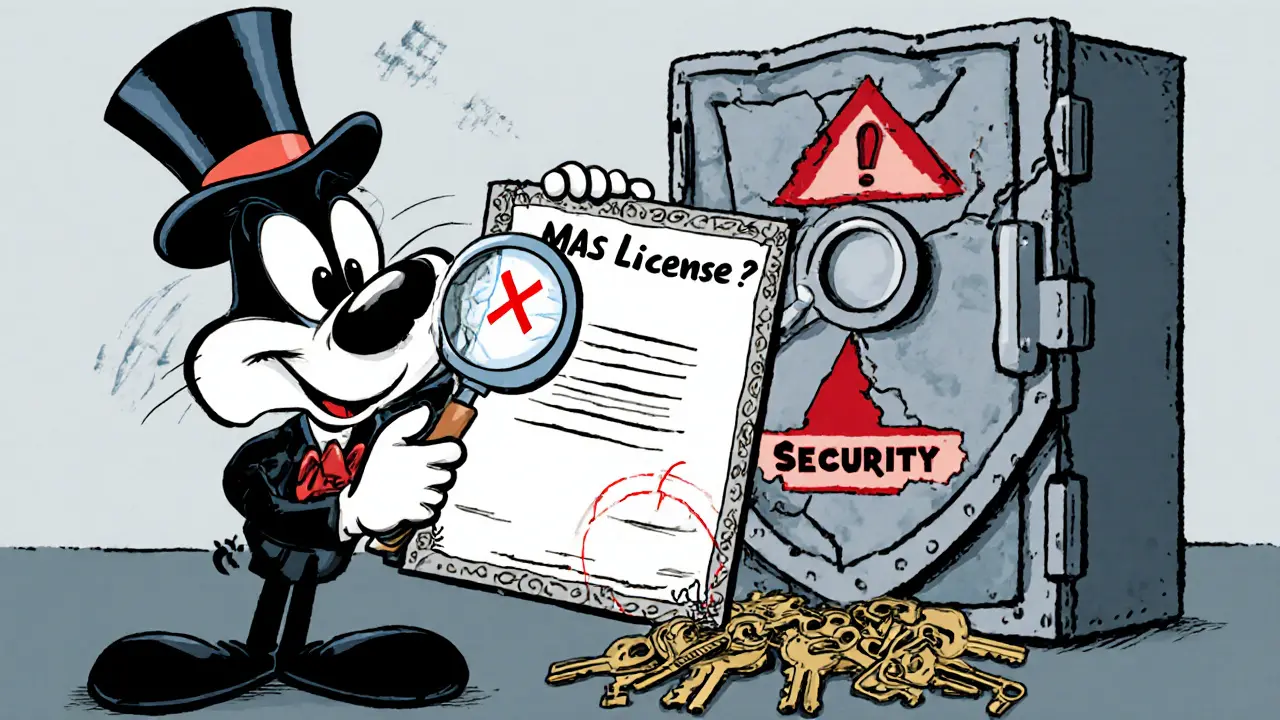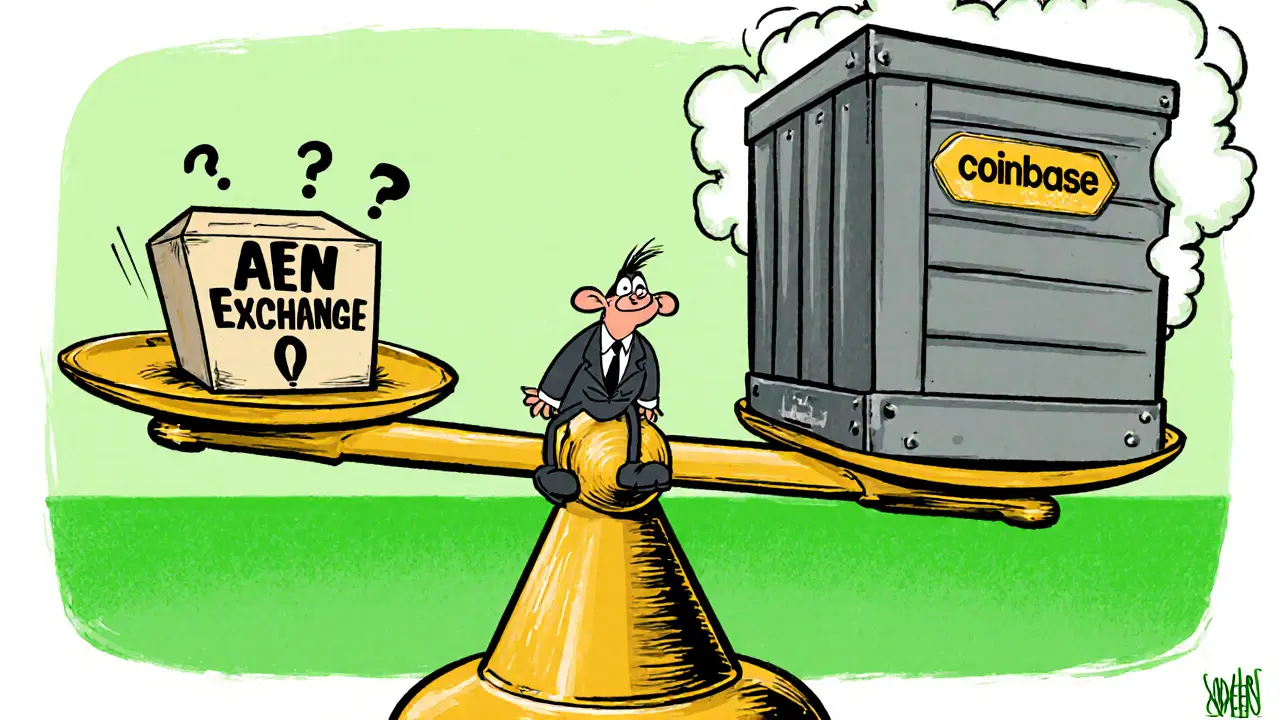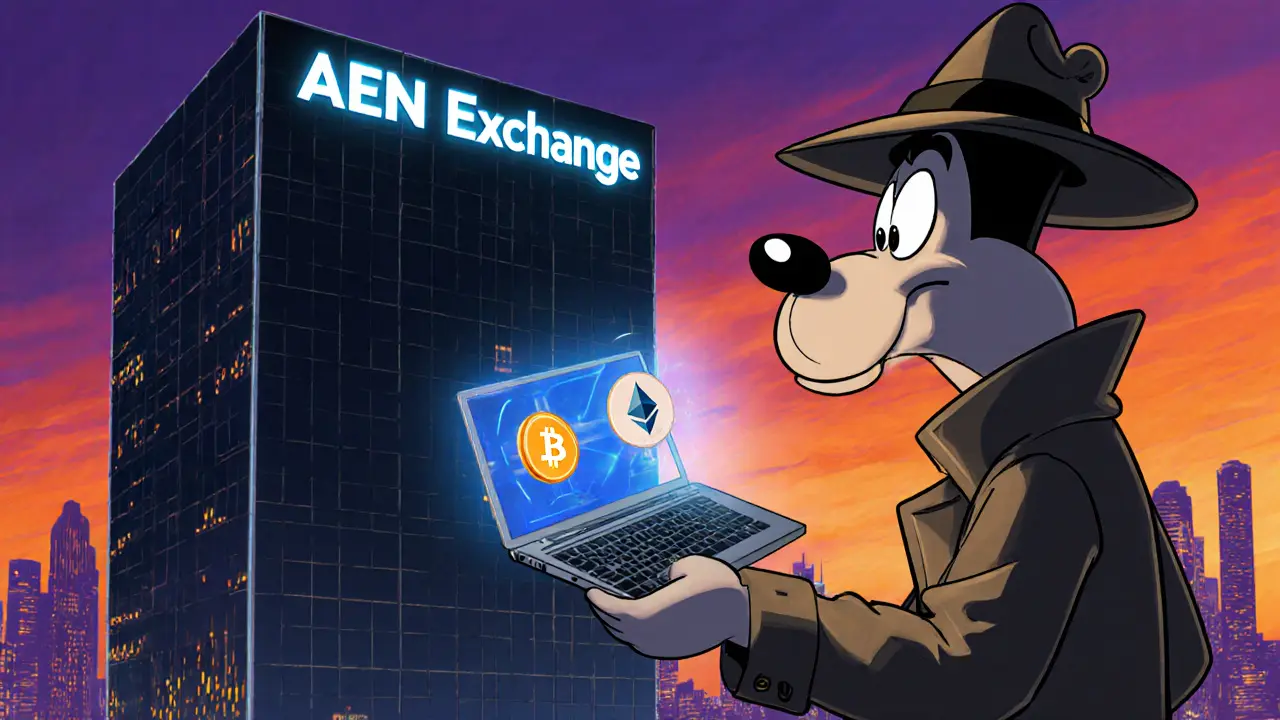AEN Exchange Risk Assessment Tool
This tool helps you assess the risks of using AEN Exchange by evaluating key factors important for cryptocurrency trading platforms.
Current Status: Medium Risk
AEN Exchange does not display any public regulatory license or MAS registration badge.
In contrast, major exchanges like Binance and Coinbase show their regulatory credentials prominently.
AEN Exchange mentions multi-signature wallets and cold storage but lacks third-party audit reports.
Reputable exchanges undergo regular security audits from firms like Trail of Bits and CertiK.
Fee schedule is hidden behind a login wall with no public disclosure.
Users must create an account to see actual fees, unlike Binance and Coinbase.
Mobile app ratings are low (3.1/5) and lacks advanced features like API access or margin trading.
Support is limited to ticket system and Asian business hours live chat.
Overall Risk Level:
High Risk
Based on the key factors evaluated, AEN Exchange presents significant risks including lack of regulatory oversight, insufficient security audits, undisclosed fees, and limited user support.
Recommendation: Only consider this platform for small test amounts with minimal exposure.
| Feature | AEN Exchange | Binance | Coinbase |
|---|---|---|---|
| Founded | ~2020 (estimated) | 2017 | 2012 |
| Supported Coins | ~15 major pairs | 500+ | 250+ |
| Trading Fees | Undisclosed / "low" | 0.1% maker / 0.1% taker | 0.5% – 0.04% (tiered) |
| Regulatory Licenses | None publicly shown | MAS, FCA, etc. | FINRA, FCA, etc. |
| Security Audits | No public audit | Regular third-party audits | Annual SOC 2, ISO-27001 |
| Customer Support | Ticket + limited live chat | 24/7 live chat, phone | 24/7 live chat, phone |
| Mobile App Rating (iOS) | 3.1 / 5 | 4.8 / 5 | 4.6 / 5 |
When you hear the name AEN Exchange is a Singapore‑based cryptocurrency exchange that claims to support major digital assets like Bitcoin and Ethereum. The platform is still a mystery for most traders, so this review pulls together everything you can actually verify before you decide whether to deposit a single cent.
What Is AEN Exchange?
AEN Exchange launched sometime before 2021 and markets itself as a “global” crypto hub. Its website lists a handful of trading pairs, a mobile app for iOS and Android, and a promise of “high‑speed order execution.” The lack of a detailed history page makes it hard to pinpoint exact founding year, but the platform appears to have been operating for at least four years.
Regulatory Landscape and Licensing
Because the exchange claims a Singapore base, it should fall under the Monetary Authority of Singapore’s (MAS) oversight. MAS requires crypto firms to hold a Capital Markets Services (CMS) licence if they accept public deposits. AEN Exchange does not display any licence number or MAS registration badge on its footer, which is a red flag for risk‑averse users. In contrast, well‑known platforms like Binance and Coinbase prominently list their regulatory credentials for every jurisdiction they serve.
Security Measures
Security is the make‑or‑break factor for any crypto exchange. AEN Exchange mentions “multi‑signature wallets” and “cold storage” but provides no third‑party audit reports. Independent security firms such as Trail of Bits and CertiK often publish audit certificates for reputable exchanges; none exist for AEN Exchange in public repositories. Without a verifiable audit, users cannot confirm whether the exchange uses industry‑standard encryption (AES‑256) or if it employs a robust key‑management system.

Fees and Trading Features
The fee schedule is hidden behind a login wall. Public pages only mention “low maker fees” and “zero taker fees for VIP members.” By comparison, Binance charges 0.1% maker/taker fees, and Coinbase Pro offers a tiered structure starting at 0.5% for low‑volume traders. AEN Exchange does publish a “0% withdrawal fee for Bitcoin,” but it does not clarify whether a network fee is still deducted, which is customary across the industry.
User Experience and Platform Tools
The web interface feels minimalist, with a dark‑mode layout and a basic order book. Mobile apps are available on the Apple App Store and Google Play, each earning an average rating of 3.1/5 based on the few reviews that exist. Features such as API access, margin trading, or copy‑trading are either absent or locked behind a “Premium” tier that requires manual verification. In contrast, Kraken offers a full‑featured API and margin products, while Bitstamp provides a straightforward fiat‑on‑ramp for beginners.
Customer Support
Support options consist of a ticket system and a live‑chat widget that only appears during Asian business hours (GMT+8). Response times reported on community forums range from 30minutes to over 24hours, depending on inquiry complexity. Established exchanges typically provide 24/7 multilingual live chat, a comprehensive knowledge base, and social‑media support channels - resources that appear limited for AEN Exchange.

How AEN Exchange Stacks Up Against the Big Players
| Feature | AEN Exchange | Binance | Coinbase |
|---|---|---|---|
| Founded | ~2020 (estimated) | 2017 | 2012 |
| Supported Coins | ~15 major pairs | 500+ | 250+ |
| Trading Fees | Undisclosed / “low” | 0.1% maker / 0.1% taker | 0.5% - 0.04% (tiered) |
| Regulatory Licences | None publicly shown | MAS, FCA, etc. | FINRA, FCA, etc. |
| Security Audits | No public audit | Regular third‑party audits | Annual SOC 2, ISO‑27001 |
| Customer Support | Ticket + limited live chat | 24/7 live chat, phone | 24/7 live chat, phone |
| Mobile App Rating (iOS) | 3.1/5 | 4.8/5 | 4.6/5 |
Pros and Cons
- Pros
- Simple interface that’s easy for absolute beginners.
- Claims zero withdrawal fee for Bitcoin (subject to network fee).
- Operates under Singapore jurisdiction, which is relatively crypto‑friendly.
- Cons
- No transparent regulatory licence or audit information.
- Limited coin selection - far fewer than industry leaders.
- Customer support only during limited hours, with mixed response times.
- Fees are not disclosed publicly, making cost comparison impossible.
Final Verdict: Should You Trade on AEN Exchange?
If you’re a crypto hobbyist who wants a no‑frills platform to move a handful of Bitcoin or Ethereum between wallets, AEN Exchange might get the job done. However, the absence of clear licensing, independent security audits, and a transparent fee schedule raises serious concerns for anyone planning to move larger sums or trade frequently.
For most traders, especially those who value security, regulatory clarity, and a wide selection of assets, established exchanges such as Binance, Kraken, or Coinbase remain the safer bets. Until AEN Exchange publishes verifiable compliance documents and third‑party audit reports, treat it as a high‑risk option and limit exposure to a small test amount.
Frequently Asked Questions
Is AEN Exchange regulated by the Monetary Authority of Singapore?
There is no public evidence of a MAS licence on the exchange’s website. Users should request the licence number directly from the platform before depositing funds.
What cryptocurrencies can I trade on AEN Exchange?
The exchange lists roughly 15 trading pairs, focusing on major assets like Bitcoin (BTC), Ethereum (ETH), Litecoin (LTC) and a few selected altcoins. It does not support many newer tokens or DeFi projects.
How do AEN Exchange’s fees compare to other platforms?
Fees are not disclosed publicly, which makes direct comparison impossible. Most users report “low maker fees” but must verify the exact percentages after creating an account.
Is there a mobile app, and how reliable is it?
Yes, AEN Exchange offers iOS and Android apps. Current ratings hover around 3.1/5, indicating mixed user experiences and occasional stability issues.
Can I withdraw my funds instantly?
The platform claims “instant Bitcoin withdrawals with zero fees,” but network congestion can still delay transactions. Withdrawal speed ultimately depends on blockchain conditions, not the exchange.

Having skimmed the rundown on AEN Exchange, I can see why the platform feels like a mixed bag for newcomers. The UI is clean enough to get you started, but the lack of clear licensing info makes me uneasy. If you’re only dabbling with a few coins, the low‑fee promise might be tempting, yet you should keep your exposure tiny until the exchange proves its skin in the game. Think of it as a test‑drive rather than a long‑term garage.
🚨🚨🚨 THIS IS A CLASSIC CASE OF “LOOK AT ME, I’M A LEGIT EXCHANGE” BUT THERE’S NO REGULATORY BADGE TO SHOW FOR IT! 🚨🚨🚨 The fact that AEN hides its fee schedule behind a login is a red flag taller than the Empire State Building. Anyone with a modicum of sense should steer clear until they publish a proper audit. 🙅♀️💥
Let’s pull back a step and frame this in a broader context. AEN’s simplicity could be a welcome landing pad for crypto newbies, yet the hidden fees and thin support could quickly turn that welcome into a nightmare. I’d suggest you dip a small amount in, monitor the withdrawal times, and only consider scaling up if the platform demonstrates transparency with a third‑party audit. Your wallet’s safety should always be the priority, not the allure of “low fees.”
i think they are trying to look pro but they be missing some key stuff like a real license and a clear audit report. also the app is buggier than i expected, like sometimes it just freeze when i try to place an order. maybe they will fix it later but right now it feels like a half baked project.
I hear you, keeping the stake tiny is the safest play.
Honestly, the fact that a Singapore‑based exchange can operate underground without a visible MAS licence feels like the regulators are either sleeping or being paid off. They could be hiding a whole network of off‑shore entities that funnel funds with no oversight. Stay skeptical and don’t hand over more than a test amount.
Looks like a no‑frills app, but the support hours are a deal‑breaker for me.
From a technical standpoint, the absence of a published SOC‑2 or ISO‑27001 attestation raises concerns about the exchange’s cryptographic key management lifecycle, especially regarding multi‑sig wallet orchestration and cold‑storage segregation protocols.
Ah, but consider the deeper philosophical implication: a platform that hides fees is not merely a commercial oversight; it is a manifestation of the age‑old paradox of trust versus transparency; we are forced to confront the existential dread that digital finance may be built upon a foundation of opacity, a veil that obscures the true cost of freedom in the blockchain era.
Listen, I’ve seen a lot of “next‑big‑thing” exchanges and most of them are smoke and mirrors. AEN’s claim of “high‑speed order execution” is just marketing hype. If they can’t even show a proper license, why should anyone trust them with real money? You’re better off sticking with the proven giants.
Hold up, you’re missing the point. Even the giants have had slip‑ups, but at least they publish their compliance docs. AEN’s silence is the red flag that should make any self‑respecting trader walk away now.
lol, these exchangess are all about the hype. if they cant show a license i’d just keep my coins in a hardware wallet. no point in risking it.
Hey, if you’re still curious, try moving a tiny amount to test the withdrawal speed. It’s a low‑risk way to see if the platform lives up to its promises without putting a lot on the line.
It is advisable, from a risk‑management perspective, to conduct a thorough due‑diligence procedure prior to allocating any substantial capital to this exchange. This includes requesting verifiable proof of regulatory compliance, reviewing third‑party audit reports, and assessing the robustness of their cold‑storage mechanisms.
From a cultural standpoint, many Southeast Asian traders value platforms that prioritize transparency and regulatory alignment. AEN’s current opaque stance may hinder its adoption among users who expect clear governance frameworks comparable to those of Binance or Coinbase.
While I acknowledge the concerns raised, it remains essential to evaluate the exchange’s operational integrity through empirical testing rather than anecdotal dismissal. A measured approach, involving limited exposure and systematic observation, will yield a more nuanced assessment.
Seriously, this whole AEN thing reads like a scam script. The “low fees” are probably a bait to lure gullible newbies, and the customer service is practically non‑existent. It’s a circus, and anyone stepping in is the clown.
The platform’s limited coin list and opaque fee structure place it at a disadvantage compared to industry leaders.
Remember, the crypto space rewards patience and knowledge. Use resources like community forums and independent audits to guide your decisions, and never risk more than you can afford to lose.
When evaluating a relatively unknown exchange such as AEN, it’s crucial to adopt a systematic framework that goes beyond the superficial marketing copy. First, verify the regulatory standing by searching official MAS registries; a missing license is a glaring omission that should raise an immediate red flag. Second, scrutinize the security architecture – request evidence of multi‑signature wallets, cold‑storage ratios, and any third‑party penetration testing reports. Third, assess fee transparency; hidden fee schedules can erode returns and hide unfavorable spreads that only become apparent after you’ve already deposited funds. Fourth, examine the user experience: the mobile app’s average rating of 3.1 out of 5 suggests recurring bugs and usability concerns that may affect trade execution. Fifth, explore the depth of supported assets – a mere fifteen trading pairs limit diversification and may indicate a lack of liquidity. Sixth, test the customer support channels during off‑hours to see if response times meet your expectations; prolonged delays can be disastrous during market volatility. Seventh, consider the exchange’s track record – look for independent reviews, community feedback, and any historical incidents of fund loss or service outages. Eighth, compare the exchange’s features, such as API access or margin trading, against established platforms; the absence of these tools can hinder advanced trading strategies. Ninth, evaluate the withdrawal process: even if the platform claims “instant Bitcoin withdrawals,” network congestion and internal processing delays can introduce hidden latency. Tenth, factor in your own risk tolerance and capital allocation strategy; allocating a modest test amount allows you to gauge performance without jeopardizing significant assets. Finally, document your findings and revisit them periodically, as exchanges can evolve their policies and infrastructure over time. By following this comprehensive checklist, you can make an informed decision that balances potential upside with the inherent risks of operating on a lesser‑known platform.
Don't forget that many of these so‑called “new” exchanges are often backed by shadowy investors looking to siphon funds under the guise of innovation; keep your eyes peeled for hidden ownership structures.
Excellent summary; remember to stay vigilant and keep learning-knowledge is the best defense against hidden pitfalls!